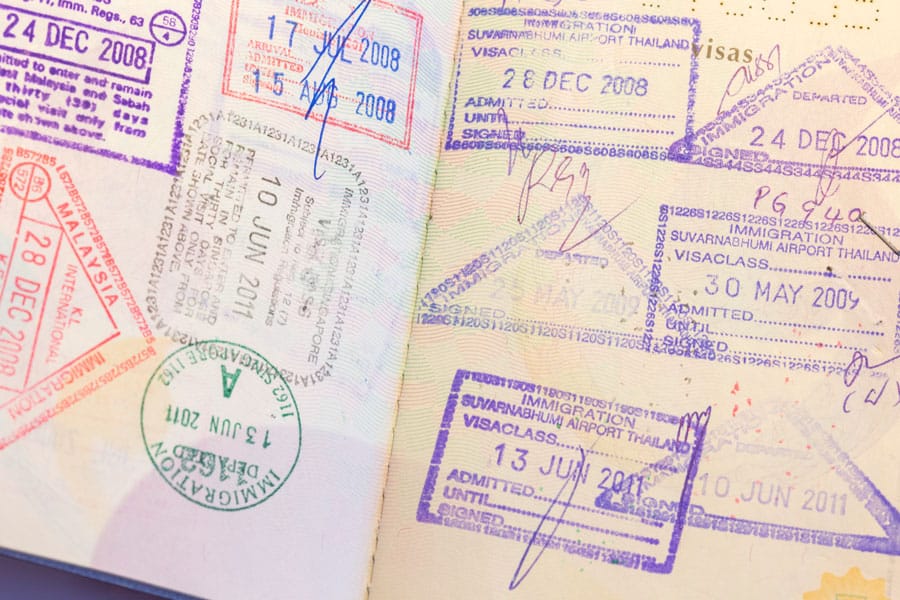
Thailand’s entry rules look simple—until you read three different websites and get three different answers. Let’s clear it up with an updated, traveler-friendly guide you can actually use.
This post covers Thailand visa requirements, the 60-day visa exemption, tourist eVisa, visa on arrival (VoA), the Thailand Digital Arrival Card (TDAC), proof of funds, fees, extensions, and the most common “oops” moments travelers run into at check-in and immigration.
Quick status check (still active as of late 2025):
✅ Thailand’s official eVisa system (thaievisa.go.th) is active. Thai E-Visa
✅ Thailand’s official TDAC site (tdac.immigration.go.th) is active and is the current arrival-card system. tdac.immigration.go.th
✅ Thai embassies/consulates and Thai Immigration offices continue to process visas and extensions under these systems. สถานเอกอัครราชทูต ณ กรุงวอร์ซอ
What are the Thailand visa requirements right now?
Thailand’s requirements depend on your nationality and how long you plan to stay, but most travelers should be ready with:
- A passport with at least 6 months validity remaining (common requirement, and specifically noted for U.S. travelers). Travel.state.gov
- A completed TDAC (Thailand Digital Arrival Card) submitted online (more on this below). tdac.immigration.go.th
- Proof of onward travel (a ticket out of Thailand within your permitted stay). สถานเอกอัครราชทูต ณ กรุงวอร์ซอ
- Proof of funds / adequate cash (or equivalent) — this is real, and immigration can ask. สถานเอกอัครราชทูต ณ กรุงวอชิงตัน+2สถานเอกอัครราชทูต ณ กรุงวอร์ซอ
And if you’re applying for a tourist visa (eVisa) instead of entering visa-exempt, you’ll typically also need:
- An online application (Thailand eVisa)
- Supporting documents (varies by visa type)
- A recent passport-style photo (often 2×2 inches on consulate checklists) สถานกงสุลใหญ่ ณ นครลอสแอนเจลิส
TDAC is now mandatory (don’t skip this)
Thailand replaced the old paper TM.6 arrival card with the Thailand Digital Arrival Card (TDAC).
- Thailand’s Immigration Bureau states all non-Thai nationals must complete TDAC online prior to entry, and indicates submission 3 days in advance of arrival. tdac.immigration.go.th
- Thai consulate guidance also describes TDAC as mandatory and walks through the steps on the official site. สถานกงสุลใหญ่ ณ นครนิวยอร์ก
What you’ll want handy for TDAC:
- Passport details
- Flight/arrival info
- Your Thailand accommodation address
- (Sometimes) health/travel history declarations สถานกงสุลใหญ่ ณ นครนิวยอร์ก
Friendly advice: do it as soon as your trip is booked (within the allowed window) so you’re not doing paperwork on airport Wi-Fi five minutes before boarding.
Do I need a visa to enter Thailand?
For many travelers, no—as long as the trip is short.
Thailand visa exemption (tourism) — up to 60 days
Thailand expanded its visa exemption program to 93 countries/territories, allowing stays up to 60 days, with a possible 30-day extension (at immigration officer discretion). Royal Thai Embassy, Doha
For U.S. travelers, the U.S. State Department notes no tourist visa required for stays under 60 days and also notes pre-arrival online registration is required. Travel.state.gov
Important reality check: Visa exemption is not “automatic entry.” Immigration always has discretion. สถานเอกอัครราชทูต ณ กรุงวอร์ซอ
What “visa exemption” usually means in real life
If you’re eligible, you typically arrive, show your passport (and TDAC confirmation), and receive an entry stamp for your permitted stay.
But you still want to be prepared to show:
- Proof of onward travel out of Thailand within your allowed period สถานเอกอัครราชทูต ณ กรุงวอร์ซอ
- Proof of funds/adequate cash or equivalent
- Some Thai embassy guidance states 20,000 THB per person / 40,000 THB per family. สถานเอกอัครราชทูต ณ กรุงวอชิงตัน+2สถานเอกอัครราชทูต ณ กรุงวอร์ซอ
Tip: If you don’t want to carry that much cash, bring a recent bank statement and make sure you have accessible funds (plus a card that works internationally). Requirements and how strictly they’re enforced can vary by officer and port of entry.
“Visa on Arrival” vs “Visa Exemption” (the mix-up that causes airport panic)
A lot of travelers hear “visa on arrival” and assume it’s what everyone does. Not true.
Visa on Arrival (VoA)
Thailand’s Visa-on-Arrival is for specific nationalities (31 listed on Thai embassy guidance) and allows a stay of up to 15 days for tourism. Royal Thai Embassy, Doha
VoA requirements commonly include:
- Completed form (available at entry points)
- One photo
- Proof of funds: 10,000 THB per person / 20,000 THB per family Royal Thai Embassy, Doha
- Passport validity at least 1 month + blank pages
- Onward ticket usable within 30 days
- Fee: 2,000 THB cash (Thai Baht) Royal Thai Embassy, Doha
Also, official guidance warns VoA visitors generally cannot extend, except special cases (like illness). Royal Thai Embassy, Doha
If you’re from the U.S., U.K., Canada, Australia, etc…
You’re typically looking at visa exemption, not VoA. (So you don’t pay the VoA fee—and you shouldn’t line up in the wrong place at the airport.)
Thailand tourist visa (eVisa): who should get it?
If you want more structure (or your nationality isn’t eligible for visa exemption), apply for a tourist visa in advance using Thailand’s official eVisa platform. Thai E-Visa
A standard tourist visa is often used when:
- You plan to stay longer than visa exemption allows (or want more certainty)
- You expect multiple entries (in some cases)
- Your travel profile triggers extra questioning at check-in/entry (frequent long stays)
Good to know: many Thai embassies/consulates now state visa applications must be submitted online via eVisa (no in-person applications). สถานเอกอัครราชทูต ณ กรุงวอร์ซอ+1
Because visa fees and document requirements vary by nationality and consulate jurisdiction, the safest move is:
Start at thaievisa.go.th and follow the prompts for your nationality and your local Thai mission. Thai E-Visa
Extending your stay in Thailand (visa exemption or tourist visa)
The common extension: +30 days
If you enter Thailand and later decide you’re not ready to leave (very relatable), many tourists can apply for an extension at a Thai Immigration Office.
Official embassy guidance notes visa-exempt stays can be extended for up to 30 additional days, at the discretion of the immigration officer. Royal Thai Embassy
Extension fee (the number travelers should remember)
A widely-cited standard immigration extension fee is 1,900 THB, typically paid in cash. ThaiEmbassy.com
What you’ll usually need for an extension appointment
Requirements can vary by office, but commonly requested items include:
- Passport + copies
- Completed extension form (often TM.7)
- A passport photo
- Proof of address in Thailand (hotel booking / TM30 receipt in some situations)
- Cash for the fee ThaiEmbassy.com
Best practice: go early in the day, bring your own photocopies, and keep a calm “I love paperwork” face.
“Visa runs” and multiple entries: what’s changed (and what hasn’t)
Thailand has long been a place where travelers do quick trips out and back to reset stay permissions—but immigration is also clear that entry is always discretionary, and frequent back-to-back stays can raise flags. สถานเอกอัครราชทูต ณ กรุงวอร์ซอ+1
Land/sea entries have a clearer limit
Thai embassy guidance states that entering Thailand via land/sea border checkpoints under visa exemption is permitted only twice in a calendar year (with a few country exceptions). Royal Thai Embassy, Doha
Airports aren’t “unlimited”
Some embassy pages note airports aren’t affected by the land/sea limit—but that doesn’t mean unlimited friction-free entries. Immigration may still question frequent long stays and repeated exits/entries. สถานเอกอัครราชทูต ณ กรุงวอร์ซอ+1
If Thailand is your long-term base, it’s often smarter to choose a visa that matches your reality (see below).
What type of Thai visa do I need? (common options)
Here’s a practical, high-level overview of common Thai visa paths travelers consider. Exact requirements vary by nationality and Thai mission.
1) Tourist stay (short-term)
- Visa Exemption (up to 60 days) + possible 30-day extension Royal Thai Embassy, Doha
- Tourist eVisa (apply online) Thai E-Visa
- Visa on Arrival (15 days) for eligible nationalities Royal Thai Embassy, Doha
2) Work, business, or study (not tourism)
If you’re working, running a business, studying, or staying longer, you’ll typically need the appropriate Non-Immigrant category and, if working, a work permit route. (This area changes often and is paperwork-heavy—follow your Thai embassy/consulate instructions carefully.)
3) Destination Thailand Visa (DTV) — the newer “workcation” lane
Thailand introduced a Destination Thailand Visa (DTV) concept for eligible applicants (often framed around remote work/workcation and certain “Thai soft power” activities). One Thai embassy page describes:
- 5-year validity, multiple entries
- 180 days per entry, with possible extension per rules
- Financial evidence requirements (example shown: 500,000 THB) สถานเอกอัครราชทูต ณ กรุงวอร์ซอ
If you’re a remote worker who keeps “living” in Thailand on tourist stays, DTV-style options are worth researching because they’re designed for that lifestyle.
4) Marriage / retirement routes
Thailand has long-running pathways for marriage and retirement stays, generally handled via Thai immigration with defined eligibility rules. Because these are more personal and document-intensive, the most accurate guidance will come from:
- Your local Thai embassy/consulate instructions, and
- Thai Immigration requirements for conversion/extension inside Thailand.
5) Permanent residency
Permanent residency has specific eligibility criteria and quotas and is typically a longer-term, documented process.
Thailand visa checklist (copy/paste friendly)
Before you fly, make sure you can confidently answer “yes” to these:
- Passport valid 6+ months
- TDAC completed (confirmation saved) tdac.immigration.go.th
- Onward travel booked (and accessible offline) สถานเอกอัครราชทูต ณ กรุงวอร์ซอ+1
- Funds available (and ideally evidence ready) Royal Thai Embassy, Doha
- If doing VoA: photo + 2,000 THB cash + required docs Royal Thai Embassy, Doha
- If applying for a visa: submitted through thaievisa.go.th Thai E-Visa
Related questions (updated)
How much is a Thai Visa on Arrival?
Official Thai embassy guidance lists the Visa-on-Arrival fee as 2,000 THB, payable cash in Thai Baht, non-refundable. Royal Thai Embassy, Doha
Is “Visa on Arrival” available to U.S., U.K., Canadian travelers?
Typically, travelers from countries like the USA and UK use visa exemption (up to 60 days) rather than VoA. Royal Thai Embassy, Doha
How long does a Thailand visa take to process?
Processing times vary by consulate, season, and visa type. Many Thai missions advise applying well ahead of travel, and some embassy pages give ballpark ranges (often around 10–15 working days for certain categories). สถานเอกอัครราชทูต ณ กรุงวอร์ซอ
Practical tip: start the eVisa process 2–3+ weeks early to avoid holiday delays and document re-requests.
Final (very Thai) word of wisdom 🌴
Thailand wants you to visit—but it also expects you to arrive prepared. If you show up with a valid passport, TDAC done, an onward ticket, and proof you can support yourself, immigration is usually smooth.
And if any website tells you “don’t worry, you can just figure it out when you land,” smile politely… and keep reading official sources instead.
As a trusted source for travel information, Vacation-Thailand.com offers up-to-date and reliable details on the visa requirements for Thailand, ensuring that your trip planning is accurate and hassle-free.
